Research News
-
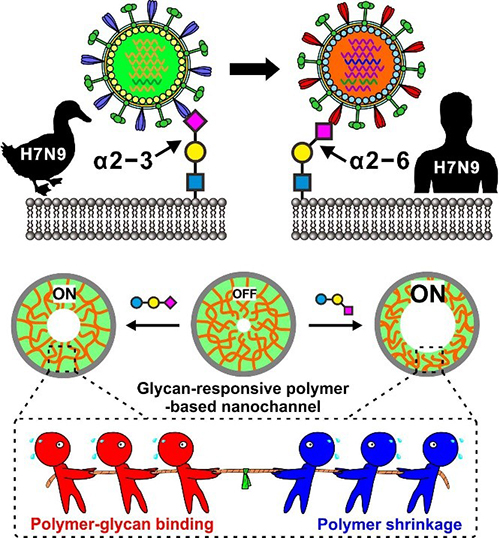 12 27, 2019DICP Scientists Develop Nanochannels Device for Precise Discrimination of Sialylated Glycan Linkage isomersScientists recently constructed a bioinspired nanochannel device and realized the precise recognition and discrimination of sialylated glycan linkage isomers. This work was published in Chemical Science.
12 27, 2019DICP Scientists Develop Nanochannels Device for Precise Discrimination of Sialylated Glycan Linkage isomersScientists recently constructed a bioinspired nanochannel device and realized the precise recognition and discrimination of sialylated glycan linkage isomers. This work was published in Chemical Science.
A research group led by Prof. QING Guangyan from the Dalian Institute of Chemical Physics (DICP) of the Chinese Academy of Sciences (CAS) recently constructed a bioinspired nanochannel device and realized the precise recognition and discrimination of sialylated glycan linkage isomers. This work was published in Chemical Science.
Design of the biomimetic nanochannels for glycan recognition. (A) H7N9 virus binds to avian a2–3-linked sialylated glycan receptor, while the reassortant H7N9 virus binds to human a2–6-linked glycan receptor. (B) Schematic illustration of glycan-induced nanochannel“OFF–ON”changes and
the tug-of-war cartoon to illustrate the competition between polymer-glycan binding and the polymer shrinkage. (Image by LI Minmin)
Sialylated glycans that are attached to cell surface mediate diverse cellular processes such as immune responses, pathogen binding, and cancer progression. Precise determination of sialylated glycans, particularly their linkage isomers that can trigger distinct biological events and are indicative of different cancer types, remains a challenge, due to their complicated composition and limited structural differences.
In this work, QING and co-workers creatively introduced the bioinspired nanochannel as its sensitive perturbation of ion flux to the recognition of glycans with subtitle difference in structure. They report a glycan-responsive polymer-modified nanochannels device, which demonstrates the capacity of recognizing and discriminating sialic acid form other neutral monosaccharides, different sialic acids, and even sialylated glycans with α2-3 and α2-6 linkage.
In-depth studies revealed a competition between the polymer shrinkage caused by electrostatic attraction and shrinkage-resistance from the strong binding of the polymer with glycan molecules, which contributed to the varying extend of shrinkage of the graft polymer in nanochannels, and the different “OFF-ON” change in ion flux and the detectable current signals.
This work broadens the application of nanochannel systems in bioanalysis and biosensing, and opens a new route to glycan analysis, for example, the single-molecule analysis of complex glycan using single nanochannel/nanopore, that could help to uncover the mysterious and wonderful glycoworld.
According to the similar strategy, the group also designed and developed the Ca2+-self-controlled bioinspired Ca2+ nanochannels (NPG Asia Materials, 2019) and the cyclic adenosine monophosphate (cAMP)-controlled ion nanochannels (J. Mater. B., 2019). These works further highlight the potential of biomolecule-responsive polymer for the construction of bioinspired ion nanochannels.
These works were supported by the National Natural Science Foundation of China, DICP Innovation Funding, and LiaoNing Revitalization Talents Program. It was dedicated to the 70th anniversary of DICP, CAS. (Text by LI Minmin Li, QING Guangyan) -
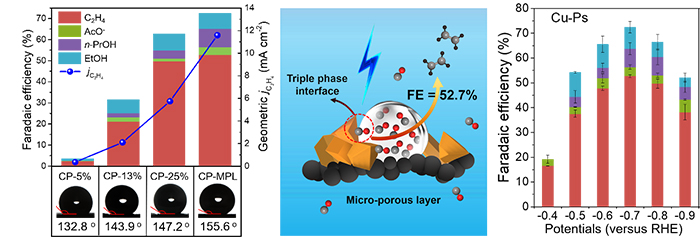 12 12, 2019Highly Selective Production of Ethylene by Electroreduction of Carbon MonoxideRecently, scientists have made a new progress in highly selective electroreduction of CO to ethylene. This work was published as a communication in Angew. Chem. Int. Ed. and was highlighted as the Hot Paper.
12 12, 2019Highly Selective Production of Ethylene by Electroreduction of Carbon MonoxideRecently, scientists have made a new progress in highly selective electroreduction of CO to ethylene. This work was published as a communication in Angew. Chem. Int. Ed. and was highlighted as the Hot Paper.
Recently, the research group led by Prof. DENG Dehui from the Dalian Institute of Chemical Physics (DICP) of the Chinese Academy of Scientists (CAS) has made a new progress in highly selective electroreduction of CO to ethylene. This work was published as a communication in Angew. Chem. Int. Ed. and was highlighted as the Hot Paper.
Performance of CO electroreduction over Cu-Ps loaded on hydrophobic carbon papers and schematic illustration for CORTE process on Cu catalysts with the assistant of the hydrophobic micro-porous layer to improve the CO diffusion. (Image by CHEN Ruixue, GAO Hehua)
Ethylene (C2H4) is an important building block for chemical industry and usually be produced by steam cracking of naphtha feedstocks at 800-900 oC worldwide. However, considering the utilization of the nonpetroleum carbon resources, converting CO from syngas (CO + H2) to C2H4 is also regard as one of the key process.
Fischer-Tropsch synthesis (FTS) is usually under high temperature (200-450 oC) and high pressure (5-50 bar), the products from FTS process are often limited by the Anderson-Schulz-Flory distribution, which leads to 30% selectivity of C2 hydrocarbons at most.
Therefore, the development of highly selective and energy-saving ethylene production route without additional separation and waste of carbon resources is of great technological, economical and environmental interest.
A highly selective production of ethylene process from electrocatalytic CO reduction with water at room temperature and ambient pressure was achieved through rational optimization of polytetrafluoroethylene content to increase CO concentration at the surface of electrode and Cu particle catalysts to enhance the C-C bond coupling.
This electrocatalytic CORTE process can achieve an unprecedentedly high ethylene FE of 52.7%. Moreover, the selectivity based on CO conversion to ethylene is around 70%, breaking through the 30% selectivity limitation from CO to C2 hydrocarbons in traditional FTS process, which always delivers uncontrollable mixture of C1-C4 hydrocarbons and massive CO2.
Besides, cooperating with Prof. SU Haiyan and Prof. ZHANG Donghui, DENG’s group studied the reaction active sites and mechanism by DFT calculations. Theoretical calculations suggest that Cu(100) is the most preferred plane for C2H4 formation via considering all possible products.
This electrocatalytic CORTE process provides a highly selective, energy-efficient and eco-friendly way to convert the abundantly industrial CO to C2H4 in comparison with the Fischer-Tropsch synthesis process.
This work was supported by Ministry of Science and Technology of China, National Natural Science Foundation of China, Key Research Program of Frontier Sciences of the Chinese Academy of Sciences, the DNL Cooperation Fund and National Postdoctoral Program for Innovative Talents, and Collaborative Innovation Center of Chemistry for Energy Materials (2011. iChEM). (Text by CHEN Ruixue and GAO Hehua) -
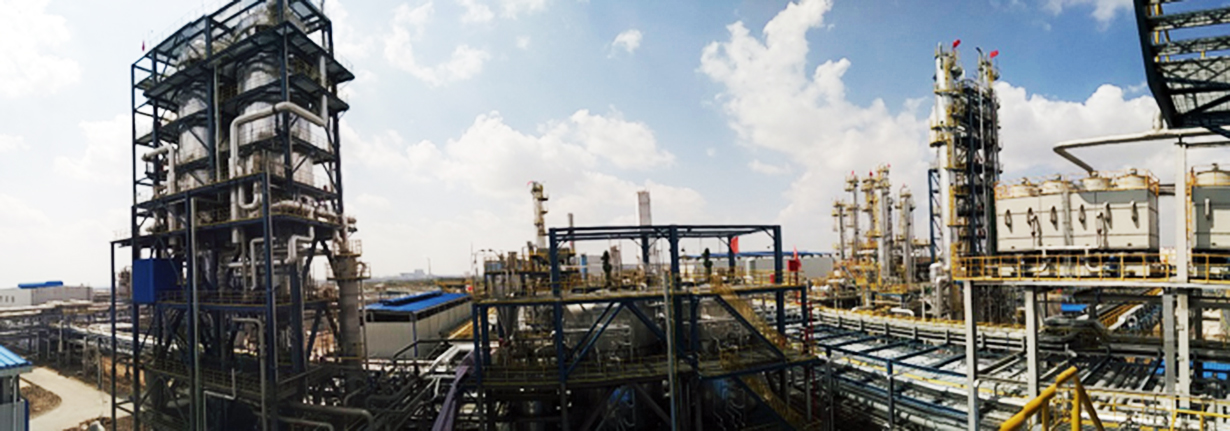 11 27, 2019New Catalyst Method Promises Better Use of Syngas, CoalThe world’s first project to industrially synthesize 25 kt/a of higher alcohols from syngas passed a continuous 72-hour catalyst performance test on 3rd November, 2019 in Yulin, Shaanxi province, china.
11 27, 2019New Catalyst Method Promises Better Use of Syngas, CoalThe world’s first project to industrially synthesize 25 kt/a of higher alcohols from syngas passed a continuous 72-hour catalyst performance test on 3rd November, 2019 in Yulin, Shaanxi province, china.
The world’s first project to industrially synthesize 25 kt/a of higher alcohols from syngas passed a continuous 72-hour catalyst performance test on 3rd November, 2019 in Yulin, Shaanxi province, china.
The project, developed by researchers from the Dalian Institute of Chemical Physics (DICP) of the Chinese Academy of Sciences, offers a new method for directly synthesizing high value-added fine chemicals from syngas and suggests new ways to cleanly convert and utilize coal resources.
Results of the catalyst test showed that at 30% of catalyst loading, total conversion of syngas exceeded 84%; selectivity of methane was less than 6%; and selectivity of alcohols/aldehydes/olefins exceeded 60%.
Higher alcohols – the key products of this process – are often used as intermediates in the synthesis of plasticizers, detergents and lubricants, and are generally produced through the Ziegler and Oxo processes. However, these processes involve drawbacks, such as cumbersome steps as well as the use of dangerous catalysts in the Ziegler process.
DICP scientists and their collaborators have been conducting basic research and industrial testing on high-selectivity production of higher alcohols from syngas over Co-based catalysts since 2004. As part of their research, they designed a series of novel Co-based catalysts, namely, activated carbon supported Co-Co2C catalysts. The active site of these catalysts is supposed to be the interfacial sites between metallic Co and cobalt carbide (Co2C).
The researchers also proposed the mechanism by which alcohols are formed on the interfacial sites between Co and the Co2C sites. That is, CO molecules are associatively adsorbed on the surface of the Co2C sites and then inserted into the alkyl chain formed on the adjacent metallic Co sites.
The new catalytic method may make Fischer-Tropsch synthesis (FTS) more practical. FTS is one of the most versatile processes for converting syngas (CO+H2) derived from coal, natural gas, and biomass into various chemical products. FTS is notable for producing high-quality paraffins. In addition, using FTS to directly synthesize olefins and oxygenates (mainly linear α- alcohols) from syngas is a promising “one-pot-one-step” method due to the high added-value and large potential demand for these olefin and oxygenate products. However, no catalytic system has performed sufficiently well for industrial implementation to date.
The results of the current catalyst test suggest that the direct conversion of syngas into high value-added fine chemicals can now be accomplished at industrial scale, thus suggesting many more opportunities for cleanly and efficiently utilizing coal resources.(Text by ZHAO Ziang) -
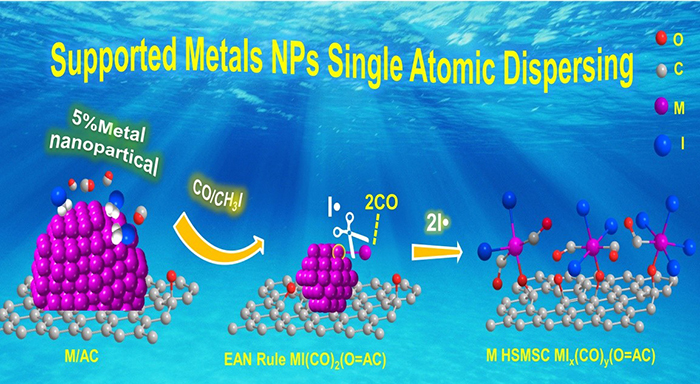 11 26, 2019DICP Researchers Develop a Universal Strategy to Mononuclear Complexes from Activated Carbon Supported Noble Metal NanoparticlesScientists developed a universal and easily scale-up strategy to atomic dispersed from activated carbon supported noble metal nanoparticles, which was published in Nature Communication.
11 26, 2019DICP Researchers Develop a Universal Strategy to Mononuclear Complexes from Activated Carbon Supported Noble Metal NanoparticlesScientists developed a universal and easily scale-up strategy to atomic dispersed from activated carbon supported noble metal nanoparticles, which was published in Nature Communication.
Recently, the research group led by Prof. DING Yunjie from the Dalian Institute of Chemical Physics (DICP) of the Chinese Academy of Scientists (CAS) has developed a universal and easily scale-up strategy to atomic dispersed from activated carbon supported noble metal nanoparticles, which was published in Nature Communication.
Supported noble metal catalysts have been used broadly in heterogeneous catalysis, and the catalyst deactivation often occurred due to sintering and agglomeration. Scientists have developed many methods to reverse this process, including oxidation and reduction, chlorination and oxychlorination, thermal treatment with halohydrocarbons.
However, many disadvantages still existed for these methods. The dispersion of nanoparticles (NPs) cannot reach to the atomic level own to the limitation of Ostwald Ripping, the operation conditions are rather harsh and rigorous, often needing very high temperature and one method usually concentrated on a single metal.
In this work, noble metal nanoparticles of Rh, Ir, Pt, Pd, Ru and Ag with 5 wt% loading supported on activated carbon (AC) can be completely dispersed into stable mononuclear complex through the thermal treatment of CO and CH3I. The dispersive process and mechanism are discussed detailed in the case of Rh metal as an example. It is found that the Rh NPs supported on AC could be efficiently transferred into the stable mononuclear complexes of Rh(CO)2I3(O-AC) and Rh(CO)I4(O-AC), in which O-AC represent the oxygen-containing groups on the surface of AC.
The combined action of proper temperature, CO, CH3I and the oxygen-containing groups on the surface of AC are indispensable for the atomic dispersion of supported NPs. Hemolytic cleavage of CH3I on the surface of Rh NPs produces large amount of free radicals (I·). The synergetic effect of CO and I· promotes the breakage of Rh-Rh bond and the formation of mononuclear complexes, leading to the gradual dispersion and decrease Rh NPs. The O-AC provides the anchoring site for the detached mononuclear complexes.
The dispersive process of nanoparticles through the thermal treatment of CO and CH3I mixture. (Image by FENG Siquan)
This work shares a universal and simple strategy to regenerate the sintered catalyst and to synthesize supported mononuclear complexes of most precious metal. It will bring about new insights and points for the design of single-metal-site catalyst. This work was supported by National Key R&D Program of China (2017YFB0602203) and the Strategic Priority Research Program of the Chinese Academy of Sciences (XDA21020300 and XDB17020400). (Text and image by SONG Xiangen and FENG Siquan).
-
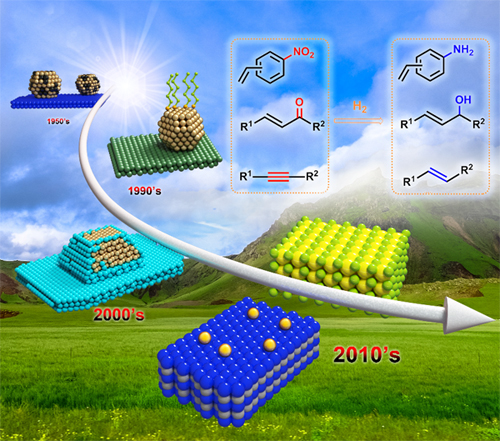 11 21, 2019Scientists review recent advances in selective hydrogenation reactionsRecently, scientists reviewed the advances in selective hydrogenation reactions catalyzed by nano- and single-atom catalysts. The review was published in Chemical Reviews.Recently, the research group led by Profs. ZHANG Tao and WANG Aiqin from the Dalian Institute of Chemical Physics (DICP), the Chinese Academy of Sciences reviewed the advances in selective hydrogenation reactions catalyzed by nano- and single-atom catalysts. The review was published in Chemical Reviews. Selective hydrogenation refers to when two (or more) reducible functional groups co-exist in the reactants, the targeted one is saturated whereas the other remains intact. Selective hydrogenation reactions have wide applications in both petrochemical and fine chemical industries. However, it remains a great challenge because of the various side reactions (e.g., over-hydrogenation) on traditional nano-catalysts.
11 21, 2019Scientists review recent advances in selective hydrogenation reactionsRecently, scientists reviewed the advances in selective hydrogenation reactions catalyzed by nano- and single-atom catalysts. The review was published in Chemical Reviews.Recently, the research group led by Profs. ZHANG Tao and WANG Aiqin from the Dalian Institute of Chemical Physics (DICP), the Chinese Academy of Sciences reviewed the advances in selective hydrogenation reactions catalyzed by nano- and single-atom catalysts. The review was published in Chemical Reviews. Selective hydrogenation refers to when two (or more) reducible functional groups co-exist in the reactants, the targeted one is saturated whereas the other remains intact. Selective hydrogenation reactions have wide applications in both petrochemical and fine chemical industries. However, it remains a great challenge because of the various side reactions (e.g., over-hydrogenation) on traditional nano-catalysts.
Chronological development of nano- and single atom catalysts for the selective hydrogenation reaction of alkynes, nitrostyrenes, and α,β-unsaturated aldehydes/ketones. (Image by ZHANG Leilei) Experimental and theoretical calculation results revealed that when the ensemble of active metal is reduced, the adsorption of the untargeted group is weakened, by which the chemoselectivity can be greatly improved. Accordingly, the “active site isolation” strategy is proposed to achieve high selectivity in hydrogenation reactions. This review summarized the approaches towards the site isolation, including adsorption/grafting of N/S/P-containing organic molecules on the metal surface, partial covering of active metal surface by metal oxides either via doping or through strong metal-support interaction, confinement of active metal nanoparticles in micro- or meso-pores of the supports, and construction of single-atom catalysts on reducible oxides or inert metals. Both advantages and disadvantages of each approach have been discussed for three types of chemoselective hydrogenation reactions, including alkynes/dienes to monoenes, α,β-unsaturated aldehydes/ketones to the unsaturated alcohols, and substituted nitroarenes to the corresponding anilines. Finally, the development directions in this area were prospected, and some advices were put forward. This work was supported by the National Key Projects for Fundamental Research and Development of China, the National Natural Science Foundation of China, the Strategic Priority Research Program of the Chinese Academy of Sciences. It was dedicated to the 70th anniversary of DICP, CAS. (Text and image by ZHANG Leilei) -
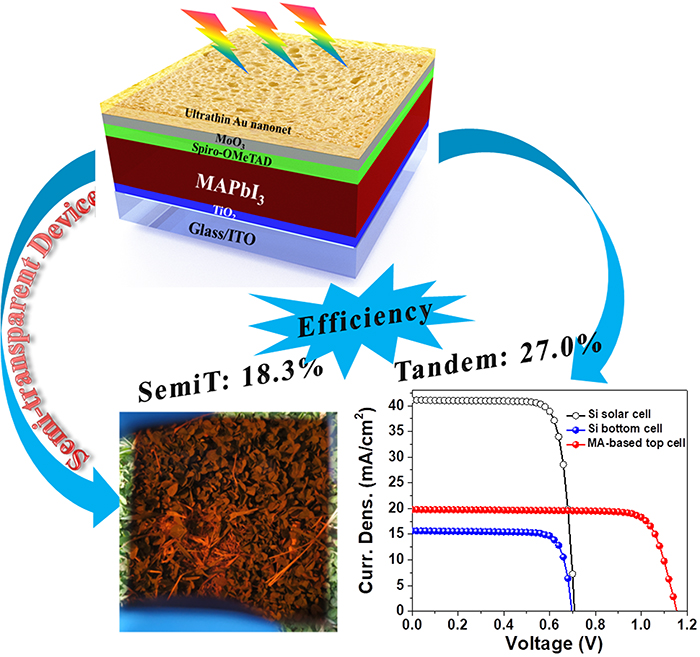 11 18, 2019DICP Scientists Develop High Efficiency Perovskite/Silicon Tandem Solar CellsScientits developed the high efficiency semi-transparent perovskite solar cells by using MoO3 sandwiched gold nanomesh (MoO3/Au/MoO3) multilayer as the transparent electrode. Combined with a superior heterojunction silicon solar cell, a high efficiency four-terminal perovskite/silicon tandem solar cell was obtained.
11 18, 2019DICP Scientists Develop High Efficiency Perovskite/Silicon Tandem Solar CellsScientits developed the high efficiency semi-transparent perovskite solar cells by using MoO3 sandwiched gold nanomesh (MoO3/Au/MoO3) multilayer as the transparent electrode. Combined with a superior heterojunction silicon solar cell, a high efficiency four-terminal perovskite/silicon tandem solar cell was obtained.
A research group led by Prof. LIU Shengzhong from the Dalian Institute of Chemical Physics (DICP) of the Chinese Academy of Sciences (CAS), and Prof. YANG Dong at Shaanxi Normal University developed the high efficiency semi-transparent perovskite solar cells by using MoO3 sandwiched gold nanomesh (MoO3/Au/MoO3) multilayer as the transparent electrode. Combined with a superior heterojunction silicon solar cell, a high efficiency four-terminal perovskite/silicon tandem solar cell was obtained. Their findings were published in Advanced Functional Materials.
The top image is the device structure of the semi-transparent perovskite cell with ultra-thin gold nanonet as transparent electrode. The left image is the photograph of the semi-transparent device. The right image shows the J-V characteristic of the semitransparent perovskite top cell (red line) , the silicon bottom cell (blue line) and the silicon cell works indepently (black line).(Image by DUAN Lianjie, WANG Ziyu)
The crystalline Si-based solar cells have been dominating the ever-expanding global photovoltaic (PV) market with about 95% market share. With its highest cell efficiency of 26.6% reaching its theoretical limit, there is little hope to further raise its performance by just device optimization within the single-junction cell architecture.
Tandem/multijunction structure was proven to be an effective way to break the Shockley-Queisser limit. To obtain a high efficiency tandem solar cell, a key of merit thing is to fabricate transparent electrode with high cinductivity as well as high transparency using a mild mrthod.
To obtain the high conductive and high transparent transparent electrode, the group demonstrated a MoO3/Au/MoO3 multilayer fabricated by thermal evaporation. The thermal evaporation is mild that could not damage the underneath layer.
The large surface tension of MoO3 effectively improves wettability for gold, resulting in Frank–van der Merwe growth to produce an ultrathin gold nanomesh layer, which guarantees not only excellent conductivity but also great optical transparency. The top MoO3 layer reduces the reflection at the gold layer to further increase light transmission.
As a result, the semitransparent perovskite cell shows an 18.3% efficiency, the highest reported for this type of devices. When the semitransparent perovskite device is mechanically stacked with a heterojunction silicon solar cell of 23.3% PCE, it yields a combined efficiency of 27.0%, higher than those of both the sub-cells. This breakthrough in elevating the efficiency of semitransparent and multijunction/tandem devices can help to break the Shockley–Queisser limit.
The research was supported by the National Natural Science Foundation of China, National Key Research and Development Program of China, Shaanxi Technical Innovation Guidance Project, the 111 Project. (Text/Image by DUAN Lianjie, WANG Ziyu)